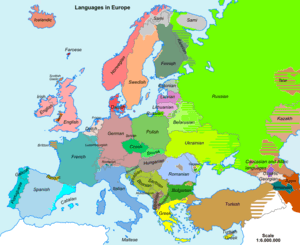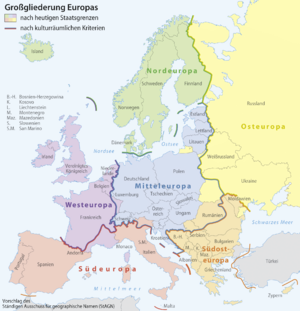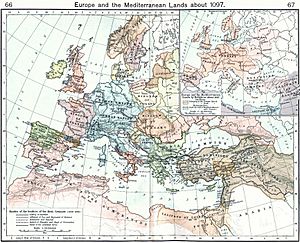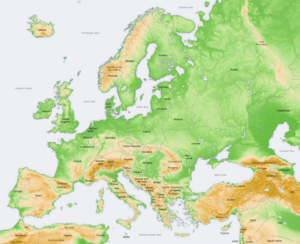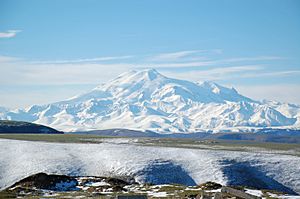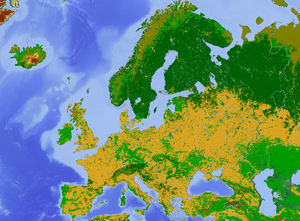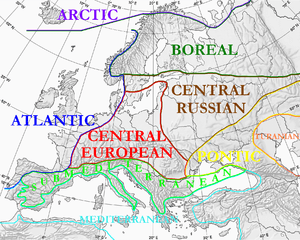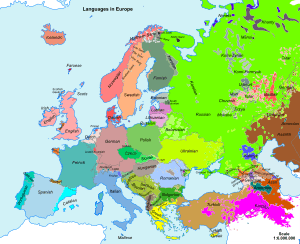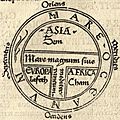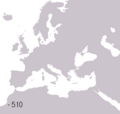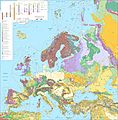Europe facts for kids
Europe is a large continent, often seen as the western part of Eurasia. It is separated from Asia by the Ural Mountains in Russia and the Bosporus strait in Turkey.
Europe has water on three sides. To the west is the Atlantic Ocean. The Arctic Ocean is to the north. The Mediterranean Sea separates Southeastern Europe from Africa. The Ural River and Ural Mountains form Europe's eastern border.
There are at least 43 countries in Europe. Some countries like Cyprus, Georgia, Kazakhstan, Russia, and Turkey are partly in Europe and partly in Asia. Most European countries are part of the European Union.
Europe covers about 10,180,000 square kilometers. This is about 2% of Earth's surface. As of 2017, about 510 million people lived in Europe.
Europe makes 44% of the world's wine. It also has Mount Etna, the continent's most active volcano. Europe is a very popular place for tourists. People visit its many World Heritage Sites and other famous places.
Contents
What Does "Europe" Mean?
Europe gets its name from "Europa," a princess in Greek mythology. The myth says that Zeus kidnapped Europa. He took her to Crete, where she became the mother of King Minos. The first civilization in Europe, the Minoans, was named after him.
The name "Europa" was first used for Greece. Later, as more cities and empires grew in the West, the whole area west of the Ural Mountains became known as "Europa."
Regions of Europe
Europe is often divided into these regions:
The European Union
Today, many countries in Europe share some leadership through a group called the European Union. This group helps countries work together on many important issues.
Europe's Past
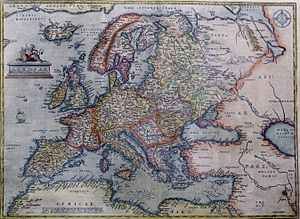
The history of Europe tells the story of people living there from ancient times to today.
The period called classical antiquity began with the first city-states in ancient Greece. Later, the Roman Empire became very powerful. It ruled the entire Mediterranean region. The fall of the Roman Empire in 476 AD is usually seen as the start of the Middle Ages.
Around the 14th century, a time of new ideas called the Renaissance began. It challenged old ways of thinking in science and religion. At the same time, the Protestant Reformation led to new churches, especially in Germany, Scandinavia, and England.
After 1800, the Industrial Revolution brought wealth to Britain and Western Europe. Major European powers also set up colonies in the Americas, Africa, and parts of Asia.
In the 20th century, World War I and World War II caused many deaths. The Cold War then shaped European politics from 1947 to 1989. After 1950, countries began to unite into what is now the European Union. Today, most countries west of Russia are part of NATO, a military alliance with the United States and Canada.
Countries in Europe
Here is a list of countries in Europe:
 Albania
Albania Armenia
Armenia Austria (EU)
Austria (EU) Azerbaijan
Azerbaijan Belarus
Belarus Belgium (EU)
Belgium (EU) Bosnia and Herzegovina
Bosnia and Herzegovina Bulgaria (EU)
Bulgaria (EU) Croatia (EU)
Croatia (EU) Czech Republic (EU)
Czech Republic (EU) Denmark (EU)
Denmark (EU) Estonia (EU)
Estonia (EU) Finland (EU)
Finland (EU) France (EU)
France (EU) Georgia
Georgia Germany (EU)
Germany (EU) Greece (EU)
Greece (EU) Hungary (EU)
Hungary (EU) Iceland Note: Geologically located in Europe and North America. (Official Candidate of EU.)
Iceland Note: Geologically located in Europe and North America. (Official Candidate of EU.) Ireland (EU)
Ireland (EU) Italy (EU)
Italy (EU) Kosovo Note: Not officially recognized.
Kosovo Note: Not officially recognized. Latvia (EU)
Latvia (EU) Liechtenstein
Liechtenstein Lithuania (EU)
Lithuania (EU) Luxembourg (EU)
Luxembourg (EU) Malta (EU)
Malta (EU) Moldova
Moldova Monaco
Monaco Montenegro (Official Candidate of EU.)
Montenegro (Official Candidate of EU.) Netherlands (EU)
Netherlands (EU) Norway
Norway Poland (EU)
Poland (EU) Portugal (EU)
Portugal (EU) Cyprus (EU)
Cyprus (EU) Republic of Macedonia (Official Candidate of EU.)
Republic of Macedonia (Official Candidate of EU.) Romania (EU)
Romania (EU) Russia
Russia Serbia (Official Candidate of EU.)
Serbia (Official Candidate of EU.) Slovakia (EU)
Slovakia (EU) Slovenia (EU)
Slovenia (EU) Spain (EU)
Spain (EU) Sweden (EU)
Sweden (EU) Switzerland
Switzerland Turkey (Official Candidate of EU.)
Turkey (Official Candidate of EU.) Ukraine
Ukraine United Kingdom (EU)
United Kingdom (EU) Vatican City
Vatican City
Europe's Geography
Europe is the western part of the Eurasian landmass. It has a very long coastline compared to its land area. Its water borders are the Arctic Ocean to the north, the Atlantic Ocean to the west, and the Mediterranean, Black, and Caspian Seas to the south.
Europe's land changes a lot over short distances. The southern parts are more mountainous, with high ranges like the Alps, Pyrenees, and Carpathians. As you go north, the land becomes hilly, then turns into wide, low plains. This large flat area is called the Great European Plain. An arc of uplands also runs along the northwestern coast, from Britain and Ireland to the mountains of Norway.
Europe's Climate
Europe is mostly in the temperate climate zones. This means it has mild weather. The climate is warmer and wetter than other places at the same latitude. This is because of the Gulf Stream. The Gulf Stream is like "Europe's central heating." It brings warm water to the coast and warms the winds that blow across the continent.
For example, the average temperature in Naples, Italy, is 16°C (61°F) all year. New York City, which is at a similar latitude, is only 12°C (54°F). Berlin, Germany, is much warmer in January than Calgary, Canada, or Irkutsk, Russia, even though they are all at similar latitudes. Northern Scotland also has a mild climate for its latitude.
Europe's Geology
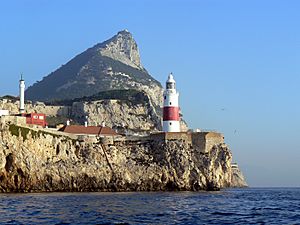
Europe's geology is very complex and varied. This creates the many different landscapes you see, from the Scottish Highlands to the flat plains of Hungary.
A key feature of Europe is the difference between the high mountains of Southern Europe and the huge, partly underwater northern plain. This plain stretches from Ireland to the Ural Mountains. The mountain ranges of the Pyrenees and Alps/Carpathians separate these two halves.
The northern plains are bordered by the Scandinavian Mountains and the mountains of the British Isles. Large shallow seas like the Celtic Sea, North Sea, Baltic Sea, and Barents Sea cover parts of these plains. The northern plain sits on an old geological continent called Baltica.
Europe's Flora
For thousands of years, people have farmed in Europe. This has greatly changed the plants and animals. Except for Fennoscandia and northern Russia, there are few areas of untouched wilderness. Most wild areas are now in national parks.
Most of Europe was once covered by mixed forest. This forest stretched from the Mediterranean Sea to the Arctic Ocean. Over half of Europe's original forests have been cut down over centuries. However, Europe still has over a quarter of its land covered by forest. These include broadleaf and mixed forests, the taiga in Scandinavia and Russia, and Cork oak forests in the western Mediterranean. Recently, people have slowed deforestation and planted many new trees.
In temperate Europe, mixed forests with both broadleaf and coniferous trees are common. Important trees in central and western Europe are beech and oak. In the north, the taiga is a mix of spruce, pine, and birch trees. Further north, the taiga changes to tundra as you get closer to the Arctic. In the Mediterranean, many olive trees grow well in the dry climate. Mediterranean Cypress trees are also widely planted. The dry Mediterranean region also has many scrub forests. A narrow strip of grassland (the steppe) extends from Ukraine and southern Russia into Hungary.
Europe's Fauna
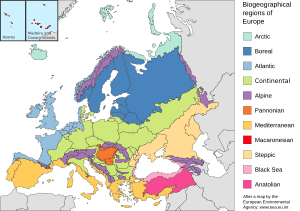
The last ice age and the presence of humans have changed where animals live in Europe. Many large animals and top predators have been hunted until they became extinct.
The woolly mammoth disappeared before the end of the Neolithic period. Today, wolves and bears are endangered. They used to live in most parts of Europe. But cutting down forests and hunting made these animals move to more remote areas. By the Middle Ages, bears mostly lived in hard-to-reach mountains with enough forest.
Today, the brown bear mainly lives in the Balkan peninsula, Scandinavia, and Russia. Small groups also live in other countries like Austria and the Pyrenees. But in these areas, brown bear groups are separated and struggling because their homes are destroyed. Also, polar bears can be found on Svalbard, a Norwegian group of islands far north of Scandinavia. The wolf, Europe's second-largest predator after the brown bear, is mostly found in Central and Eastern Europe and the Balkans. Some packs also live in parts of Western Europe like Scandinavia and Spain.
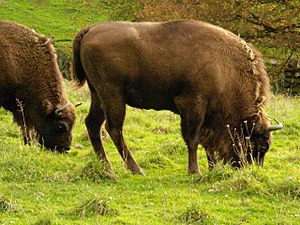
Other European animals include wild cats, foxes (especially the red fox), jackals, and different types of martens and hedgehogs. There are also many reptiles like snakes (vipers and grass snakes) and amphibians. Many birds live here, such as owls, hawks, and other birds of prey.
Important plant-eating animals in Europe include snails, larvae, fish, various birds, and mammals. These mammals include rodents, deer, boars, and mountain animals like marmots, steinbocks, and chamois. Many insects, like the small tortoiseshell butterfly, also add to the variety of life.
The disappearance of dwarf hippos and dwarf elephants is linked to the first humans arriving on the islands of the Mediterranean.
Sea creatures are also a big part of Europe's wildlife. The sea plants are mainly phytoplankton. Important animals in European seas include zooplankton, molluscs, echinoderms, different crustaceans, squids, octopuses, fish, dolphins, and whales.
Europe protects its amazing variety of life through the Bern Convention. The European Community and other countries have also signed this agreement.
People of Europe
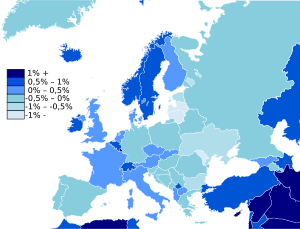
In 2017, about 742 million people lived in Europe. This is a little more than one-ninth of the world's population. This number includes Siberia but not European Turkey.
A hundred years ago, nearly a quarter of the world's population lived in Europe. Europe's population has grown, but populations in other parts of the world, especially Africa and Asia, have grown much faster. Europe has a high population density, meaning many people live in a small area. Only Asia has more people per square mile. Most of Europe has Sub-replacement fertility, which means each new generation has fewer people than the one before it.
The country with the most people per square mile in Europe, and in the world, is the tiny country of Monaco.
Languages of Europe
Most European languages belong to three main Indo-European groups:
- The Romance languages come from Latin, the language of the Roman Empire.
- The Germanic languages came from southern Scandinavia.
- The Slavic languages.
Slavic languages are spoken by the most native speakers in Europe. They are found in Central, Eastern, and Southeastern Europe. Romance languages are mainly spoken in southwestern Europe, as well as in Romania and Moldova in Eastern Europe. Germanic languages are spoken in Northern Europe, the British Isles, and parts of Central Europe.
Many other languages exist in Europe outside these three groups. Other Indo-European languages include the Baltic group (like Latvian and Lithuanian), the Celtic group (like Irish, Scottish Gaelic, Manx, Welsh, Cornish, and Breton), Greek, Armenian, and Albanian.
Also, a different group of Uralic languages (Estonian, Finnish, and Hungarian) is mainly spoken in Estonia, Finland, and Hungary. Kartvelian languages (Georgian, Mingrelian, and Svan) are mostly spoken in Georgia. Two other language families are in the North Caucasus: Northeast Caucasian (including Chechen, Avar, and Lezgin) and Northwest Caucasian (including Adyghe).
Maltese is the only Semitic language that is official in the EU. Basque is a unique language in Europe, not related to any other known language family. Turkic languages include Azerbaijani and Turkish, plus languages of smaller groups in Russia.
Europe aims to support many languages and protect regional and minority languages. The Council of Europe has rules like the Framework Convention for the Protection of National Minorities and the European Charter for Regional or Minority Languages to protect language rights.
Europe's Culture
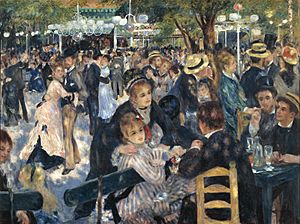
The idea of "Europe" as a culture comes from the shared history of the Roman Empire and its culture. Historically, Europe's borders were often seen as the borders of Christendom. This was especially true during times of conflict, like the Reconquista and the Ottoman wars in Europe.
This shared cultural background mixes with many local national cultures and folklores. These are generally divided into Slavic, Latin (Romance), and Germanic cultures. But there are also unique groups like Greek, Basque, and Celtic.
Many cultural events are held in Europe to bring different cultures together. They also help people learn about the importance of these cultures. Examples include the European Capital of Culture, the European Region of Gastronomy, the European Youth Capital, and the European Capital of Sport.
Images for kids
-
A medieval T and O map printed in 1472. It shows the three continents as lands of Noah's sons: Asia for Sem (Shem), Europe for Iafeth (Japheth), and Africa for Cham (Ham).
-
Stonehenge in the United Kingdom, built between 3000 and 2000 BCE.
-
An animation showing how the Roman Empire grew and divided over the years.
-
Viking raids and the division of the Frankish Empire in 843, after the Treaty of Verdun.
-
The maritime republics of medieval Italy. They helped connect Europe, Asia, and Africa through trade and colonies. They also played a big role in the Crusades.
-
Tancred of Sicily and Philip II of France meeting during the Third Crusade (1189–1192).
-
The city of Suzdal being attacked by Batu Khan in 1238, during the Mongol invasion of Europe.
-
The School of Athens by Raphael (1511). It shows famous people of the Renaissance, like Michelangelo and Leonardo da Vinci (in the center), as ancient scholars.
-
Lands ruled by the Habsburgs after Charles V, Holy Roman Emperor divided them. Their main military route in Europe was the Spanish road from the Netherlands to the Duchy of Milan.
-
The borders of Europe set by the Congress of Vienna in 1815.
-
Marshall's Temple Works (1840). The Industrial Revolution began in Great Britain.
-
Nazi Germany started a terrible World War II in Europe, led by Adolf Hitler. Here, Hitler is with his ally, Italian dictator Benito Mussolini, in 1940.
-
The "Big Three" leaders at the Yalta Conference in 1945: Winston Churchill, Franklin D. Roosevelt, and Joseph Stalin.
-
The Schuman Declaration led to the creation of the European Coal and Steel Community. This started the integration process for the European Union (May 9, 1950, at the French Foreign Ministry).
-
The fall of the Berlin Wall in 1989.
See also
 In Spanish: Europa para niños
In Spanish: Europa para niños



